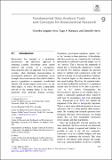Files in this item
Fundamental data analysis tools and concepts for bioacoustical research
Item metadata
| dc.contributor.author | Salgado Kent, Chandra | |
| dc.contributor.author | Marques, Tiago A. | |
| dc.contributor.author | Harris, Danielle | |
| dc.contributor.editor | Erbe, Christine | |
| dc.contributor.editor | Thomas, Jeanette A. | |
| dc.date.accessioned | 2022-10-07T14:30:16Z | |
| dc.date.available | 2022-10-07T14:30:16Z | |
| dc.date.issued | 2022-10-04 | |
| dc.identifier | 281629776 | |
| dc.identifier | 2ff42f94-a78c-471a-9d9a-bb00d5edcc98 | |
| dc.identifier | 85157977376 | |
| dc.identifier.citation | Salgado Kent , C , Marques , T A & Harris , D 2022 , Fundamental data analysis tools and concepts for bioacoustical research . in C Erbe & J A Thomas (eds) , Exploring animal behavior through sound : volume 1: methods . Springer , Cham , pp. 319-354 . https://doi.org/10.1007/978-3-030-97540-1_9 | en |
| dc.identifier.isbn | 9783030975401 | |
| dc.identifier.isbn | 9783030975401 | |
| dc.identifier.other | RIS: urn:D239CFDDB93A549C07153ED4C24719F8 | |
| dc.identifier.other | RIS: Salgado Kent2022 | |
| dc.identifier.other | ORCID: /0000-0003-1447-1420/work/120433287 | |
| dc.identifier.other | ORCID: /0000-0002-2581-1972/work/120434027 | |
| dc.identifier.uri | https://hdl.handle.net/10023/26157 | |
| dc.description.abstract | Bioacoustics is a growing field of research in which sound is measured to gain knowledge about species’ natural history and their environments. For example, bioacousticians have been able to create phylogenies, identify populations, and estimate abundance using sound. Moreover, today, many animals are exposed to human-generated noise, which can impact animals’ behavior, ability to communicate, physiology, hearing, and, in some instances, survival. Bioacoustics, thus, is commonly used to assess and predict the impacts of anthropogenic noise on animals and their populations. The use of bioacoustics to address such research questions, however, is only effective provided the quantitative and statistical analysis methods used are adequate and reliable. While it may not be reasonable to expect a single researcher working in bioacoustics to master all three fields required in bioacoustical research (i.e., biology, acoustics, and statistics), bioacousticians should understand basic statistical concepts, have good knowledge of existing techniques for data analysis, and identify possible pitfalls in survey design. In addition, bioacousticians should be able to conduct a range of current standard analyses, produce informative visualizations, and know when to engage a statistician to perform more sophisticated analyses. This chapter introduces common terms, concepts, and statistical methods available to analyze bioacoustical data. Not surprisingly, most are concepts and methods that could be used for any applied research topic, not necessarily just bioacoustics. The authors’ aim is for this chapter to expose users with no or limited experience in quantitative methods in bioacoustics to key analytical considerations for making valid inferences from acoustic data. | |
| dc.format.extent | 36 | |
| dc.format.extent | 1030706 | |
| dc.language.iso | eng | |
| dc.publisher | Springer | |
| dc.relation.ispartof | Exploring animal behavior through sound | en |
| dc.subject | QH301 Biology | en |
| dc.subject | MCC | en |
| dc.subject.lcc | QH301 | en |
| dc.title | Fundamental data analysis tools and concepts for bioacoustical research | en |
| dc.type | Book item | en |
| dc.contributor.institution | University of St Andrews. School of Mathematics and Statistics | en |
| dc.contributor.institution | University of St Andrews. Scottish Oceans Institute | en |
| dc.contributor.institution | University of St Andrews. Centre for Research into Ecological & Environmental Modelling | en |
| dc.contributor.institution | University of St Andrews. Sea Mammal Research Unit | en |
| dc.identifier.doi | https://doi.org/10.1007/978-3-030-97540-1_9 | |
| dc.identifier.url | https://doi.org/10.1007/978-3-030-97540-1 | en |
| dc.identifier.url | https://discover.libraryhub.jisc.ac.uk/search?isn=9783030975401&rn=1 | en |
This item appears in the following Collection(s)
Items in the St Andrews Research Repository are protected by copyright, with all rights reserved, unless otherwise indicated.

